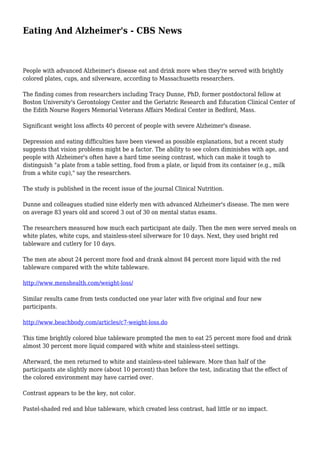
Eating And Alzheimer's - CBS News
- 1. Eating And Alzheimer's - CBS News People with advanced Alzheimer's disease eat and drink more when they're served with brightly colored plates, cups, and silverware, according to Massachusetts researchers. The finding comes from researchers including Tracy Dunne, PhD, former postdoctoral fellow at Boston University's Gerontology Center and the Geriatric Research and Education Clinical Center of the Edith Nourse Rogers Memorial Veterans Affairs Medical Center in Bedford, Mass. Significant weight loss affects 40 percent of people with severe Alzheimer's disease. Depression and eating difficulties have been viewed as possible explanations, but a recent study suggests that vision problems might be a factor. The ability to see colors diminishes with age, and people with Alzheimer's often have a hard time seeing contrast, which can make it tough to distinguish "a plate from a table setting, food from a plate, or liquid from its container (e.g., milk from a white cup)," say the researchers. The study is published in the recent issue of the journal Clinical Nutrition. Dunne and colleagues studied nine elderly men with advanced Alzheimer's disease. The men were on average 83 years old and scored 3 out of 30 on mental status exams. The researchers measured how much each participant ate daily. Then the men were served meals on white plates, white cups, and stainless-steel silverware for 10 days. Next, they used bright red tableware and cutlery for 10 days. The men ate about 24 percent more food and drank almost 84 percent more liquid with the red tableware compared with the white tableware. http://www.menshealth.com/weight-loss/ Similar results came from tests conducted one year later with five original and four new participants. http://www.beachbody.com/articles/c7-weight-loss.do This time brightly colored blue tableware prompted the men to eat 25 percent more food and drink almost 30 percent more liquid compared with white and stainless-steel settings. Afterward, the men returned to white and stainless-steel tableware. More than half of the participants ate slightly more (about 10 percent) than before the test, indicating that the effect of the colored environment may have carried over. Contrast appears to be the key, not color. Pastel-shaded red and blue tableware, which created less contrast, had little or no impact.
- 2. Calling their findings "encouraging," the researchers suggest that caregivers consider using high- contrast tableware to help people with advanced Alzheimer's disease view their environment and help them eat and drink better. SOURCES: Dunne, T. Clinical Nutrition, August 2004; vol 23: pp 533-538. News release, Boston University. By Miranda Hitti Reviewed by Brunilda Nazario, MD © 2004, WebMD Inc. All rights reserved © 2004 WebMD, LLC.. All Rights Reserved.